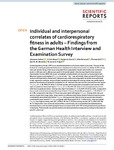Individual and interpersonal correlates of cardiorespiratory fitness in adults – Findings from the German Health Interview and Examination Survey
Zeiher, Johannes
Manz, Kristin
Kuntz, Benjamin
Perumal, Nita
Keil, Thomas
Mensink, Gert B. M.
Finger, Jonas D.
Cardiorespiratory fitness (CRF) is an established predictor of adverse health outcomes. The aim of this study is to investigate potential behavioral, interpersonal and socioeconomic correlates of CRF among men and women living in Germany using data from a population-based nationwide cross-sectional study. 1,439 men and 1,486 women aged 18–64 participated in the German Health Interview and Examination Survey (2008–2011) and completed a standardized sub-maximal cycle ergometer test. Maximal oxygen consumption (V˙O2max) in ml·min−1·kg−1 was estimated. Mean values of VO2max for various anthropometric, behavioral, interpersonal, and sociodemographic variables were estimated. Linear regression analyses using multiple imputations technique for missing values was performed to analyze the influence of potential correlates on CRF. Women with high alcohol consumption had higher V˙O2max, (β = 2.20; 95% CI 0.98 to 3.42) than women with low alcohol consumption and women with high occupational status had higher V˙O2max (β = 1.83; 95% CI 0.21 to 3.44) in comparison to women with low occupational status. Among men, high fruit intake (β = 1.52; 95% CI 0.63 to 2.40), compared to low or medium fruit intake and performing at least 2.5 hours of total PA per week (β = 2.19; 95% CI 1.11 to 3.28), compared to less than 2.5 hours was associated with higher V˙O2max. Among both men and women, lower body mass index, lower waist circumference and higher levels of physical exercise were considerably associated with higher V˙O2max. Among women, those in higher age groups showed a considerably lower level of V˙O2max compared with those aged 18–24. Furthermore, mean estimated V˙O2max was higher among men (36.5; 95% CI 36.0 to 37.0) than among women (30.3; 95% CI 29.8 to 30.7). Despite the cross-sectional nature of the current study, we conclude that several behavioral, anthropometric, and sociodemographic factors are associated with CRF in the general adult population in Germany. These results can provide evidence to tailor prevention measures according to the needs of specific subgroups.

